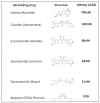Resistance to Antiandrogens in Prostate Cancer: Is It Inevitable, Intrinsic or Induced?
- PMID: 33477370
- PMCID: PMC7829888
- DOI: 10.3390/cancers13020327
Resistance to Antiandrogens in Prostate Cancer: Is It Inevitable, Intrinsic or Induced?
Abstract
Increasingly sophisticated therapies for chemical castration dominate first-line treatments for locally advanced prostate cancer. However, androgen deprivation therapy (ADT) offers little prospect of a cure, as resistant tumors emerge rather rapidly, normally within 30 months. Cells have multiple mechanisms of resistance to even the most sophisticated drug regimes, and both tumor cell heterogeneity in prostate cancer and the multiple salvage pathways result in castration-resistant disease related genetically to the original hormone-naive cancer. The timing and mechanisms of cell death after ADT for prostate cancer are not well understood, and off-target effects after long-term ADT due to functional extra-prostatic expression of the androgen receptor protein are now increasingly being recorded. Our knowledge of how these widely used treatments fail at a biological level in patients is deficient. In this review, I will discuss whether there are pre-existing drug-resistant cells in a tumor mass, or whether resistance is induced/selected by the ADT. Equally, what is the cell of origin of this resistance, and does it differ from the treatment-naïve tumor cells by differentiation or dedifferentiation? Conflicting evidence also emerges from studies in the range of biological systems and species employed to answer this key question. It is only by improving our understanding of this aspect of treatment and not simply devising another new means of androgen inhibition that we can improve patient outcomes.
Keywords: androgen deprivation therapy: tumor resistance; androgens; model systems; prostate cancer.
Conflict of interest statement
The author declares no conflict of interest.
Figures










Similar articles
-
Timing of androgen deprivation monotherapy and combined treatments in castration-sensitive and castration-resistant prostate cancer: a narrative review.World J Urol. 2020 Mar;38(3):601-611. doi: 10.1007/s00345-019-02704-y. Epub 2019 Mar 4. World J Urol. 2020. PMID: 30830274 Review.
-
Targeting the androgen receptor signaling pathway in advanced prostate cancer.Am J Health Syst Pharm. 2022 Jul 22;79(15):1224-1235. doi: 10.1093/ajhp/zxac105. Am J Health Syst Pharm. 2022. PMID: 35390118 Review.
-
Pre-existing Castration-resistant Prostate Cancer-like Cells in Primary Prostate Cancer Promote Resistance to Hormonal Therapy.Eur Urol. 2022 May;81(5):446-455. doi: 10.1016/j.eururo.2021.12.039. Epub 2022 Jan 17. Eur Urol. 2022. PMID: 35058087 Free PMC article.
-
Intermittent androgen deprivation therapy in advanced prostate cancer.Curr Treat Options Oncol. 2014 Mar;15(1):127-36. doi: 10.1007/s11864-013-0272-2. Curr Treat Options Oncol. 2014. PMID: 24395278 Review.
-
ADT with antiandrogens in prostate cancer induces adverse effect of increasing resistance, neuroendocrine differentiation and tumor metastasis.Cancer Lett. 2018 Dec 28;439:47-55. doi: 10.1016/j.canlet.2018.09.020. Epub 2018 Sep 15. Cancer Lett. 2018. PMID: 30227222 Review.
Cited by
-
Androgen Receptor-Dependent Mechanisms Mediating Drug Resistance in Prostate Cancer.Cancers (Basel). 2021 Mar 26;13(7):1534. doi: 10.3390/cancers13071534. Cancers (Basel). 2021. PMID: 33810413 Free PMC article. Review.
-
Establishment of a Novel Combined Nomogram for Predicting the Risk of Progression Related to Castration Resistance in Patients With Prostate Cancer.Front Genet. 2022 May 10;13:823716. doi: 10.3389/fgene.2022.823716. eCollection 2022. Front Genet. 2022. PMID: 35620461 Free PMC article.
-
Therapy resistance in prostate cancer: mechanism, signaling and reversal strategies.Explor Target Antitumor Ther. 2024;5(5):1110-1134. doi: 10.37349/etat.2024.00266. Epub 2024 Aug 29. Explor Target Antitumor Ther. 2024. PMID: 39351434 Free PMC article. Review.
-
Mechanisms of Prostate Cancer Cells Survival and Their Therapeutic Targeting.Int J Mol Sci. 2023 Feb 2;24(3):2939. doi: 10.3390/ijms24032939. Int J Mol Sci. 2023. PMID: 36769263 Free PMC article. Review.
-
In Vitro Analysis of Deoxynivalenol Influence on Steroidogenesis in Prostate.Toxins (Basel). 2021 Sep 26;13(10):685. doi: 10.3390/toxins13100685. Toxins (Basel). 2021. PMID: 34678978 Free PMC article.
References
-
- Yang D.D., Mahal B.A., Muralidhar V., Martin N.E., Orio P.F., Mouw K.W., King M.T., Choueiri T.K., Trinh Q.-D., Hoffman K.E., et al. Androgen Deprivation Therapy and Overall Survival for Gleason 8 Versus Gleason 9–10 Prostate Cancer. Eur. Urol. 2019;75:35–41. doi: 10.1016/j.eururo.2018.08.033. - DOI - PubMed
Publication types
LinkOut - more resources
Full Text Sources
Other Literature Sources

